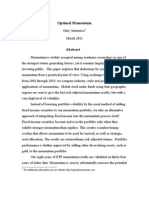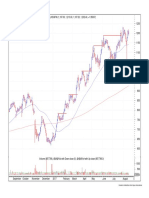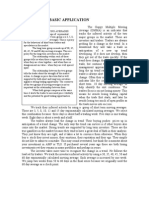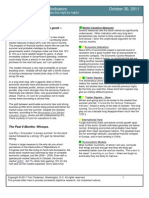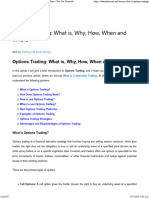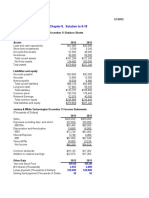Volume Spread Analysis (VSA) in Trading
Volume Spread Analysis (VSA) in Trading
Uploaded by
siulam1973gmCopyright:
Available Formats
Volume Spread Analysis (VSA) in Trading
Volume Spread Analysis (VSA) in Trading
Uploaded by
siulam1973gmOriginal Title
Copyright
Available Formats
Share this document
Did you find this document useful?
Is this content inappropriate?
Copyright:
Available Formats
Volume Spread Analysis (VSA) in Trading
Volume Spread Analysis (VSA) in Trading
Uploaded by
siulam1973gmCopyright:
Available Formats
Volume Spread Analysis (VSA) in Trading: A Comprehensive Guide https://dotnettutorials.
net/lesson/volume-spread-analysis-in-trading/
Volume Spread Analysis in Trading
Back to: Trading with Smart Money
Volume Spread Analysis (VSA) in Trading
In this article, I will discuss Volume Spread Analysis (VSA) in Trading. Please read our previous article, in
which we discussed Volume Price Action Analysis in detail. At the end of this article, you will understand the
following pointers.
1. What is Volume Spread Analysis (VSA) in Trading?
2. How Do We Use Volume Spread Analysis in Trading?
3. Market structure with respect to volume spread analysis.
4. Volume Spread Analysis.
5. Selling Climax.
6. Stopping Volume.
7. How do you trade based on selling climax and stopping volume?
MARKET STRUCTURE With Respect To Volume Spread Analysis
Let us understand bullish trend formation. The bearish trend turned into a bullish trend
Price goes through 4 phases. These are
PhaseA. Stopping the previous bearish trend
PhaseB. Construction of the cause (accumulation)
PhaseC. Test for confirmation (testing supply after accumulation)
PhaseD. Bullish Trend out of range.
1 από 20 6/5/2024, 3:15 μ.μ.
Volume Spread Analysis (VSA) in Trading: A Comprehensive Guide https://dotnettutorials.net/lesson/volume-spread-analysis-in-trading/
We will come to this market structure later. Just understand the overall concept.
How to analyze volume activity in the chart
1. Through volume price action(VPA) (discussed in the previous article)
2. Through volume spread analysis(VSA) (we will discuss in this article)
Let’s understand how to differentiate different types of volumes, like
1. Average volume
2. Below average volume
3. High volume
4. Ultra-high volume
Now, we have four types of volume. Let’s find out in the chart
Volume always moves in a cycle.
Rule -: You can visually compare Mountain Peaks to identify volume peak structure. The key is to understand
the structure of the peak clearly. Volume peak has the following characteristics:
Rising Volume — Peak (Highest Point)— Falling Volume
2 από 20 6/5/2024, 3:15 μ.μ.
Volume Spread Analysis (VSA) in Trading: A Comprehensive Guide https://dotnettutorials.net/lesson/volume-spread-analysis-in-trading/
Average and Above Average Volume: Above Average Volume is the Highest Volume in the current session,
which is higher than the average volume but lower than the previous peak Volume. Average Volume is the
volume that coincides with the Moving Average 20 of the volume indicator.
High volume and Ultra-high volume: high volume equals the previous pick volume. Ultra-high volume is the
Highest Volume in the current session. It is higher than the previous peak volume.
Bearish and Bullish Volume
Bearish Volume is marked in Red, and it shows bearish activity. Bullish Volume is marked in green, and it shows
bullish activity. If demand volume is greater than supply volume, then overall bullish volume
3 από 20 6/5/2024, 3:15 μ.μ.
Volume Spread Analysis (VSA) in Trading: A Comprehensive Guide https://dotnettutorials.net/lesson/volume-spread-analysis-in-trading/
VOLUME SPREAD ANALYSIS (VSA) in Trading
In volume spread analysis, a few facts are required for chart analysis. These facts are:
1. price movement,
2. volume(the intensity of the trading)
3. the relationships between price movement and volume (harmony or divergence)
4. the time required for all the movements to run their respective action
4 από 20 6/5/2024, 3:15 μ.μ.
Volume Spread Analysis (VSA) in Trading: A Comprehensive Guide https://dotnettutorials.net/lesson/volume-spread-analysis-in-trading/
Components of volume Spread Analysis:
1. The Volume (i.e., activity),
2. The Spread (i.e., the range of the price bar)
3. The Close (the closing price of the current bar)
Spread: Spread is the difference between the Opening and closing of the price. See the diagram below for
further illustration.
Volume: Volume is the activity of the frequency of transactions of the price change during a specified period of
time.
Close: Close price tells us where the balance point is at the end of the period.
Upside move with respect to volume
1. The smart money has no interest in the upside – Low volume.
2. Smart money is selling into the public buying – Higher volume.
5 από 20 6/5/2024, 3:15 μ.μ.
Volume Spread Analysis (VSA) in Trading: A Comprehensive Guide https://dotnettutorials.net/lesson/volume-spread-analysis-in-trading/
6 από 20 6/5/2024, 3:15 μ.μ.
Volume Spread Analysis (VSA) in Trading: A Comprehensive Guide https://dotnettutorials.net/lesson/volume-spread-analysis-in-trading/
Read Part1 and Part2 for a better understanding
SIGN OF STRENGTH BASED ON VOLUME SPREAD ANALYSIS
Recall the market structure that we have discussed above
7 από 20 6/5/2024, 3:15 μ.μ.
Volume Spread Analysis (VSA) in Trading: A Comprehensive Guide https://dotnettutorials.net/lesson/volume-spread-analysis-in-trading/
Sign of strength means. The stopping action of the downtrend
Phase A. Stopping the previous bearish trend (the sign of strength)
Again, recall the volume interpretation
• Smart money has no interest in the upside – Low volume.
• Smart money is selling into the public buying – Higher volume.
• The ultra-high volume-the classic trap of “Smart Money
Now, we have found two important rules for volume spread analysis
• Rule Number 1-- Weakness appears on an Up candle. Supply when it comes, it comes on an up
candle.
• Rule Number 2-- Strength Appears on a Down candle. Demand when it comes, it comes on a down
candle.
Some volume spread analysis that suggests the end of the downtrend. These are
1. Selling climax
2. Stopping volume
8 από 20 6/5/2024, 3:15 μ.μ.
Volume Spread Analysis (VSA) in Trading: A Comprehensive Guide https://dotnettutorials.net/lesson/volume-spread-analysis-in-trading/
3. End of falling market
Now, we will discuss these 3 pointers
What is a selling climax?
This condition marks the end of the approaching end of a particular downtrend. This panic selling by retailers (or
the public) creates an extreme expansion of the price spread and an expansion of the volume. This action may
occur over one day or over several days, which is matched by buying (demand) of:
1. experienced smart money
2. large interests
The classic characteristics of a selling climax:
• There must be a trend to reverse. (after a significant extended down move on the time frame of interest )
• The trend will accelerate to the downside with wide spreads down, closing in the middle or high.
• Volume expands dramatically
• Often occurs one more than one bar
• Must be tested for entry
9 από 20 6/5/2024, 3:15 μ.μ.
Volume Spread Analysis (VSA) in Trading: A Comprehensive Guide https://dotnettutorials.net/lesson/volume-spread-analysis-in-trading/
A secondary reaction generally follows a selling climax. Why?
Two possible outcomes after selling climax
1. Either the professional money is BUYING into the SELLING [see the end of a DOWN market].
2. There is a trading range OR technical support level to the left and. (trend continuation)
Let’s first understand a trend continuation after selling the climax.
If buying during the Selling Climax was principally to support prices temporarily and check a panic or relieve a
panicky situation, this support stock will continue after a technical bounce from support. If price supply is
sufficient to drive prices through the lows of the climax day and bring about a new decline, that is a resumption
of liquidation.
10 από 20 6/5/2024, 3:15 μ.μ.
Volume Spread Analysis (VSA) in Trading: A Comprehensive Guide https://dotnettutorials.net/lesson/volume-spread-analysis-in-trading/
Trend reversal after selling climax
After a technical rally, if prices test the climax low with decreasing volume and hold around or above the climax
lows, then we have an indication of support and the completion of liquidation. This tells us that there is no selling
pressure or supply (i.e., no more sellers), which is an obvious conclusion that the market will rally, as shown on
the right side of the image.
If the ‘test’ is successful, we can expect higher prices, especially if the test is on low volume and narrow spread
down bar into the same area where you first saw the very high volume. This is a strong BUY signal.
Time To Buy The Market AFTER TEST
1. Look for selling climax.
2. Wait for the successful test(lower volume and narrower spread)OF selling climax day low.
3. Any reversal candlestick pattern(like engulfing or outside bar or pin bar)
4. Buy above that candle
5. STOP LOSS below the low
11 από 20 6/5/2024, 3:15 μ.μ.
Volume Spread Analysis (VSA) in Trading: A Comprehensive Guide https://dotnettutorials.net/lesson/volume-spread-analysis-in-trading/
12 από 20 6/5/2024, 3:15 μ.μ.
Volume Spread Analysis (VSA) in Trading: A Comprehensive Guide https://dotnettutorials.net/lesson/volume-spread-analysis-in-trading/
Stopping volume
What is stopping volume?
• To stop a down move, demand has to overcome the supply
• It is the volume of smart money coming into the market and stopping it from falling further
• What is happening is that the weight of the selling pressure has become so great at this point that even
the smart money moving into the market has insufficient muscle to stop the market from falling in one
session. It takes two or three sessions for the brakes to be applied and is like our tanker.
Characteristics of stopping volume
• Demand overcoming supply
• Occur after an extended down move
• Volume expand significantly
• Bar close-mid or high and body narrow (lower shadow)
• Often occurs one more than one bar. The first bar close may be low 2nd bar close-mid or high
13 από 20 6/5/2024, 3:15 μ.μ.
Volume Spread Analysis (VSA) in Trading: A Comprehensive Guide https://dotnettutorials.net/lesson/volume-spread-analysis-in-trading/
Two possible outcomes after seeing the stopping volume
If the volume had represented SELLING, how can the spread be narrow? Only two possible outcomes exist for
a narrow spread DOWN-day on a very high volume.
1. Either the professional money is BUYING into the SELLING [see the end of a DOWN market].
2. There is a trading range to the left, and the professional money is prepared to absorb the buying from
traders from the support region.
Trend continuation after seeing stopping volume
This topic will be covered in the next separate article
Trend Reversal After Seeing Stopping Volume
After seeing the stopping volume. If the ‘test’ is successful, we can expect higher prices, especially if the test is
on low volume and narrow spread down bar into the same area where you first saw the very high volume. This
is a strong BUY signal.
14 από 20 6/5/2024, 3:15 μ.μ.
Volume Spread Analysis (VSA) in Trading: A Comprehensive Guide https://dotnettutorials.net/lesson/volume-spread-analysis-in-trading/
How do you trade after seeing stopping volume?
Time To Buy The Market AFTER TEST
1. If the day closes on the lows, you must wait to see what happens next.
2. If the next day is level or up, this must surely show buying on the previous day.
3. wait for the market to come back down into the area of stopping volume on LOW VOLUME narrower
spread
4. The time to buy the market is when we begin to trend up As the trend begins. Any reversal candlestick
pattern (like engulfing or outside bar or pin bar). This shows us that there are no sellers or no Supply.
5. Buy above that candle.
6. STOP LOSS below the low
In the next article, I will discuss Reversal Candlestick Pattern Analysis in detail. In this article, I will try to
explain volume spread analysis in trading. I hope you enjoy this article. Please join my Telegram Channel,
YouTube Channel, and Facebook Group to learn more and clear your doubts.
Dot Net Tutorials
About the Author: Pranaya Rout
Pranaya Rout has published more than 3,000 articles in his 11-year career. Pranaya Rout
has very good experience with Microsoft Technologies, Including C#, VB, ASP.NET MVC,
ASP.NET Web API, EF, EF Core, ADO.NET, LINQ, SQL Server, MYSQL, Oracle, ASP.NET Core,
15 από 20 6/5/2024, 3:15 μ.μ.
You might also like
- Day Trading Vol 1 Make A Living Day TradingDocument153 pagesDay Trading Vol 1 Make A Living Day Tradingsiulam1973gm100% (3)
- The Candlestick Pattern PlaybookDocument159 pagesThe Candlestick Pattern Playbooksiulam1973gm100% (1)
- Exhaustion Extension - The Swing ReportDocument12 pagesExhaustion Extension - The Swing Reportlounes.lou20100% (1)
- Candlestick Mastery Beginner To Pro in 66 PatternsDocument156 pagesCandlestick Mastery Beginner To Pro in 66 Patternssiulam1973gm100% (3)
- CHAPTER 16 SolutionsDocument5 pagesCHAPTER 16 Solutionsjiggy20010% (1)
- Variable Life Licensing Mock ExamDocument8 pagesVariable Life Licensing Mock ExamLance Lim100% (1)
- Stock Bee @comito Questions Answered For TimelineDocument2 pagesStock Bee @comito Questions Answered For TimelineJoão TrocaNo ratings yet
- The Right Stock at The Right TimeDocument6 pagesThe Right Stock at The Right TimegigikozNo ratings yet
- Peter Aan - SIMPVARDocument3 pagesPeter Aan - SIMPVARanalyst_anil14No ratings yet
- Mergers & AquisitionsDocument36 pagesMergers & AquisitionsJay KishanNo ratings yet
- Fin 435Document6 pagesFin 435api-536471641No ratings yet
- Point and Figure Relative Strength Signals: by John Lewis, Senior Portfolio Manager, Nasdaq Dorsey WrightDocument5 pagesPoint and Figure Relative Strength Signals: by John Lewis, Senior Portfolio Manager, Nasdaq Dorsey WrightmanojvarrierNo ratings yet
- F2011 OptimalMomentum2 GaryantonacciDocument28 pagesF2011 OptimalMomentum2 GaryantonacciNagy ZoltánNo ratings yet
- Find The Slam Dunks by Todd KruegerDocument7 pagesFind The Slam Dunks by Todd KruegernothankyousNo ratings yet
- Wyckoff Skill BuildingDocument6 pagesWyckoff Skill BuildingNam NguyenNo ratings yet
- Metastock RSC Exploration PDFDocument5 pagesMetastock RSC Exploration PDFRaam Mk100% (1)
- MT Metastock Part 3 Relative Strength Comparison RSC The Key Success Tool in Trading by Stock Market SectorsDocument2 pagesMT Metastock Part 3 Relative Strength Comparison RSC The Key Success Tool in Trading by Stock Market SectorsJustGentleNo ratings yet
- Chart3 - IBULHSGFINDocument1 pageChart3 - IBULHSGFINanalyst_anil14No ratings yet
- Advance Get NotesDocument14 pagesAdvance Get NotesParesh PanchalNo ratings yet
- 2016HedgeFundManagerBook v1Document19 pages2016HedgeFundManagerBook v1jeet1970100% (1)
- Computer Analysis of The Futures MarketDocument34 pagesComputer Analysis of The Futures Marketteclas71No ratings yet
- Enhanced Momentum StrategiesDocument63 pagesEnhanced Momentum StrategiesMarnetNo ratings yet
- Session - 3Document24 pagesSession - 3harshkumar patelNo ratings yet
- Top 10 Technical Indicators For Agri Commodity Market Part 1Document40 pagesTop 10 Technical Indicators For Agri Commodity Market Part 1sharathNo ratings yet
- 2 Episodic Pivot Map YouTube Presentation 2Document36 pages2 Episodic Pivot Map YouTube Presentation 2a kNo ratings yet
- Taking RSI To The Next LevelDocument23 pagesTaking RSI To The Next LevelstcsrtNo ratings yet
- Signs of Strength in A Reversal: by Al BrooksDocument4 pagesSigns of Strength in A Reversal: by Al Brooksrufao086No ratings yet
- ScrutsDocument6 pagesScrutsRodrigo OliveiraNo ratings yet
- SSRN Id3002624Document37 pagesSSRN Id3002624teppeiNo ratings yet
- Crabel, Toby - Price Patterns in Soybeans (Stocks & Commodities)Document6 pagesCrabel, Toby - Price Patterns in Soybeans (Stocks & Commodities)Leonardo LopezNo ratings yet
- Extract Pages From Larry Pesavento & Leslie Jouflas - Trade What You See. How To Profit From Patterns Recognotion - Extract - OPRSDocument6 pagesExtract Pages From Larry Pesavento & Leslie Jouflas - Trade What You See. How To Profit From Patterns Recognotion - Extract - OPRSSIightlyNo ratings yet
- Guppy Multiple Moving AverageDocument6 pagesGuppy Multiple Moving AverageJaime GuerreroNo ratings yet
- Zacks BreakoutsDocument8 pagesZacks Breakoutssabhat5No ratings yet
- High Tight Flags With Dolan V. Kent - by Kay KlingsonDocument15 pagesHigh Tight Flags With Dolan V. Kent - by Kay KlingsonpksNo ratings yet
- Volume AnalysisDocument3 pagesVolume Analysisamar_pmishra4590No ratings yet
- Live Market Seminar CurriculumDocument33 pagesLive Market Seminar CurriculumRui LopesNo ratings yet
- Ratio AnalysisDocument12 pagesRatio AnalysisMrunmayee MirashiNo ratings yet
- Tom Demark Trendlines Indicator DescriptionDocument1 pageTom Demark Trendlines Indicator DescriptionMd Saiful IslamNo ratings yet
- RSI 2 Aug Sept 2016Document44 pagesRSI 2 Aug Sept 2016gaadinaNo ratings yet
- LAB CAPITAL MANAGEMENT RevisedDocument38 pagesLAB CAPITAL MANAGEMENT RevisedBen2pop170686100% (1)
- TomT Stock Market Model October 30 2011Document20 pagesTomT Stock Market Model October 30 2011Tom TiedemanNo ratings yet
- Order Flow Free LibraryDocument5 pagesOrder Flow Free Librarybconstantin371No ratings yet
- BB As An Entry TechniqueDocument6 pagesBB As An Entry TechniquekosurugNo ratings yet
- 55 Gold FeverDocument5 pages55 Gold FeverACasey101No ratings yet
- Wyckoff Method ProjectDocument9 pagesWyckoff Method ProjectBruceLaiWeiNo ratings yet
- The Point and Figure Distribution ParadoxDocument3 pagesThe Point and Figure Distribution ParadoxACasey101No ratings yet
- Technical ResearchDocument30 pagesTechnical Researchamit_idea1No ratings yet
- VSA Analysis Supply and DemandDocument4 pagesVSA Analysis Supply and DemandminhducNo ratings yet
- Technical Indicator - RSIDocument1 pageTechnical Indicator - RSIDfunz WilphenNo ratings yet
- Frozen in Analysis ParalysisDocument8 pagesFrozen in Analysis ParalysisAhmad Azwar AmaladiNo ratings yet
- Daily Investments PSAR ADX Volume Trend IndicatorDocument9 pagesDaily Investments PSAR ADX Volume Trend IndicatorKuma KaraevNo ratings yet
- Color Based System For Short Term TradingDocument2 pagesColor Based System For Short Term TradingstiglommerNo ratings yet
- Tips For Profitable Breakout TradingDocument3 pagesTips For Profitable Breakout TradingRunny PicassoNo ratings yet
- Book Name 01Document11 pagesBook Name 01Tanvir AhmedNo ratings yet
- LocatinDocument9 pagesLocatinivolatNo ratings yet
- Orderflowsdeltatradingcourse Lesson4deltatradesetupsDocument80 pagesOrderflowsdeltatradingcourse Lesson4deltatradesetupsxufdddNo ratings yet
- Saitta A Range Breakout TradingDocument5 pagesSaitta A Range Breakout TradingArp PitNo ratings yet
- Thermostat Trading StrategyDocument7 pagesThermostat Trading StrategyTony BaloneyNo ratings yet
- Harmonic PattrensDocument49 pagesHarmonic PattrensSoufiane ChaterNo ratings yet
- A Tale of Two TradersDocument4 pagesA Tale of Two Tradersmayankjain24inNo ratings yet
- Wyckoff Trading Course (WTC) : March 11Document14 pagesWyckoff Trading Course (WTC) : March 11MtashuNo ratings yet
- Lifespan Investing: Building the Best Portfolio for Every Stage of Your LifeFrom EverandLifespan Investing: Building the Best Portfolio for Every Stage of Your LifeNo ratings yet
- The Value and Momentum Trader: Dynamic Stock Selection Models to Beat the MarketFrom EverandThe Value and Momentum Trader: Dynamic Stock Selection Models to Beat the MarketNo ratings yet
- Supply and Demand TradingDocument4 pagesSupply and Demand Tradingsiulam1973gmNo ratings yet
- Market Structure in TradingDocument12 pagesMarket Structure in Tradingsiulam1973gmNo ratings yet
- Candlestick Pattern AnalysisDocument9 pagesCandlestick Pattern Analysissiulam1973gmNo ratings yet
- Understanding Market Structure Through SwingDocument20 pagesUnderstanding Market Structure Through Swingsiulam1973gmNo ratings yet
- Technical Analysis in TradingDocument5 pagesTechnical Analysis in Tradingsiulam1973gmNo ratings yet
- Options Trading: What Is, Why, How, When and WhereDocument15 pagesOptions Trading: What Is, Why, How, When and Wheresiulam1973gmNo ratings yet
- 4 Things I Wish I Knew When I Started TradingDocument6 pages4 Things I Wish I Knew When I Started Tradingsiulam1973gmNo ratings yet
- BTST (Buy Today Sell Tomorrow) TRADING STRATEGYDocument6 pagesBTST (Buy Today Sell Tomorrow) TRADING STRATEGYsiulam1973gmNo ratings yet
- How To Study Candlestick in TradingDocument6 pagesHow To Study Candlestick in Tradingsiulam1973gmNo ratings yet
- Mental Fitness for TradersDocument36 pagesMental Fitness for TradersVikas SareenNo ratings yet
- Initiating Coverage Report - TVS Motor Company LTDDocument14 pagesInitiating Coverage Report - TVS Motor Company LTDshreya2626No ratings yet
- Islamic Asset and Fund Management: Learning ObjectivesDocument23 pagesIslamic Asset and Fund Management: Learning ObjectivesFazal Ur Rehman Wali MuhammadNo ratings yet
- A Project Report On ULIP Unit Linked Insurance Plan PDFDocument45 pagesA Project Report On ULIP Unit Linked Insurance Plan PDFRima. SapkalNo ratings yet
- Cloud Mining Platform with Clean Energy: BCH Miner Provides Free Mining ServicesDocument5 pagesCloud Mining Platform with Clean Energy: BCH Miner Provides Free Mining ServicesPR.comNo ratings yet
- 59456181584Document3 pages59456181584Abeer Abd ElatifNo ratings yet
- Walk The Talk: ESG Mutual Fund Voting On Shareholder ProposalsDocument46 pagesWalk The Talk: ESG Mutual Fund Voting On Shareholder ProposalssgNo ratings yet
- France Tax LawDocument22 pagesFrance Tax LawGary SinghNo ratings yet
- Exercise 13Document40 pagesExercise 13JA Mie CompbellNo ratings yet
- Reviewer For Gen. Math 2nd QuarterDocument3 pagesReviewer For Gen. Math 2nd QuarterguilegabrielalogNo ratings yet
- RFID at The Metro: Group 8Document6 pagesRFID at The Metro: Group 8Aakash SahrawatNo ratings yet
- Case 1Document3 pagesCase 1alegpontonNo ratings yet
- P 2011 Global TreasuryDocument22 pagesP 2011 Global TreasurymartinsiklNo ratings yet
- CRISIL MF Ranking Methodology Sep 11Document2 pagesCRISIL MF Ranking Methodology Sep 11Pallab DasNo ratings yet
- Risk and ReturnDocument2 pagesRisk and ReturnTimothy james PalermoNo ratings yet
- 22414-10743-Financial Accounting Apr-06Document7 pages22414-10743-Financial Accounting Apr-06LalithaNo ratings yet
- Pillar3 ENGDocument133 pagesPillar3 ENGInternal AuditNo ratings yet
- Apoorva DeshpandeDocument89 pagesApoorva DeshpandeManish ChouhanNo ratings yet
- IFM11 Solution To Ch08 P15 Build A ModelDocument2 pagesIFM11 Solution To Ch08 P15 Build A ModelDiana Soriano50% (2)
- Abhijeet Patnaik SIP ReportDocument44 pagesAbhijeet Patnaik SIP ReportchalakrishiNo ratings yet
- 20-06-2024 (Chapter 3&4) HW ProblemsDocument2 pages20-06-2024 (Chapter 3&4) HW ProblemsMohanNo ratings yet
- Assignment 1 Outline and Guideline UpdateDocument4 pagesAssignment 1 Outline and Guideline UpdateĐan Nguyễn PhươngNo ratings yet
- Financial Analysis of Janata Bank LimitedDocument8 pagesFinancial Analysis of Janata Bank LimitedBirendra Dasaudi100% (1)
- Journal of Empirical Finance: Xudong Fu, Tian Tang, Xinyan YanDocument20 pagesJournal of Empirical Finance: Xudong Fu, Tian Tang, Xinyan YanMashiur RahmanNo ratings yet
- 101 Question AccountingDocument49 pages101 Question AccountingnishaantchaturvediNo ratings yet
- 10 1108 - Jerer 10 2019 0035Document20 pages10 1108 - Jerer 10 2019 0035Dylan LevyNo ratings yet















